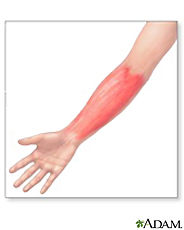Cellulitis is a bacterial infection involving the skin. It specifically affects the dermis and subcutaneous fat. Signs and symptoms include an area of redness which increases in size over a couple of days. The borders of the area of redness are generally not sharp and the skin may be swollen. While the redness often turns white when pressure is applied this is not always the case. The area of infection is usually painful. Lymphatic vessels may occasionally be involved and the person may have a fever and feel tired.
The legs and face are the most common site involved, though cellulitis can occur on any part of the body. The leg is typically affected following a break in the skin. Other risk factors include obesity, leg swelling, and old age. For face infections a break in the skin beforehand is not usually the case. The bacteria most commonly involved are streptococci and Staphylococcus aureus. In contrast to cellulitis, erysipelas is a bacterial infection involving the more superficial layers of the skin, presents with an area of redness with well-defined edges, and more often is associated with fever. More serious infections such as an underlying bone infection or necrotizing fasciitis should be ruled out.
Diagnosis is usually based on the presenting signs and symptoms with cell culture rarely being possible. Treatment with antibiotics taken by mouth such as cephalexin, amoxicillin or cloxacillin is often used. In those who are seriously allergic to penicillin, erythromycin or clindamycin may be used. When methicillin-resistant Staphylococcus aureus (MRSA) is a concern doxycycline or trimethoprim/sulfamethoxazole may, in addition, be recommended. Concern is related to the presence of pus or previous MRSA infections. Steroids may speed recovery in those on antibiotics. Raising the infected area may be useful as may pain killers.
Around 95% of people are better after seven to ten days of treatment. Potential complications include abscess formation. Skin infections affect about 2 out of every 1000 people per year. Cellulitis in 2010 resulted in about 27,000 deaths worldwide that year. In the United Kingdom cellulitis was the reason for 1.6% of admissions to the hospital.
Signs and symptoms
The typical signs and symptoms of cellulitis is an area which is red, hot, and painful. The photos shown here of are of mild to moderate cases, and are not representative of earlier stages of the condition.
Causes

Cellulitis is caused by a type of bacteria entering the skin, usually by way of a cut, abrasion, or break in the skin. This break does not need to be visible. Group A Streptococcus and Staphylococcus are the most common of these bacteria, which are part of the normal flora of the skin, but normally cause no actual infection while on the skin's outer surface.
Dental infections account for approximately 80% of cases of Ludwig's angina, or cellulitis of the submandibular space. Mixed infections, due to both aerobes and anaerobes, are commonly associated with the cellulitis of Ludwig's angina. Typically this includes alpha-hemolytic streptococci, staphylococci and bacteroides groups.
Predisposing conditions for cellulitis include insect or spider bite, blistering, animal bite, tattoos, pruritic (itchy) skin rash, recent surgery, athlete's foot, dry skin, eczema, injecting drugs (especially subcutaneous or intramuscular injection or where an attempted intravenous injection "misses" or blows the vein), pregnancy, diabetes and obesity, which can affect circulation, as well as burns and boils, though there is debate as to whether minor foot lesions contribute.
Occurrences of cellulitis may also be associated with the rare condition hidradenitis suppurativa.
The appearance of the skin will assist a doctor in determining a diagnosis. A doctor may also suggest blood tests, a wound culture or other tests to help rule out a blood clot deep in the veins of the legs. Cellulitis in the lower leg is characterized by signs and symptoms similar to those of a deep vein thrombosis, such as warmth, pain and swelling (inflammation).
This reddened skin or rash may signal a deeper, more serious infection of the inner layers of skin. Once below the skin, the bacteria can spread rapidly, entering the lymph nodes and the bloodstream and spreading throughout the body. This can result in influenza-like symptoms with a high temperature and sweating or feeling very cold with shaking, as the sufferer cannot get warm.
In rare cases, the infection can spread to the deep layer of tissue called the fascial lining. Necrotizing fasciitis, also called by the media "flesh-eating bacteria", is an example of a deep-layer infection. It is a medical emergency.
Risk factors
The elderly and those with immunodeficiency (a weakened immune system) are especially vulnerable to contracting cellulitis. Diabetics are more susceptible to cellulitis than the general population because of impairment of the immune system; they are especially prone to cellulitis in the feet, because the disease causes impairment of blood circulation in the legs, leading to diabetic foot/foot ulcers. Poor control of blood glucose levels allows bacteria to grow more rapidly in the affected tissue, and facilitates rapid progression if the infection enters the bloodstream. Neural degeneration in diabetes means these ulcers may not be painful and thus often become infected. Those who have suffered poliomyelitis are also prone because of circulatory problems, especially in the legs.
Immunosuppressive drugs, and other illnesses or infections that weaken the immune system, are also factors that make infection more likely. Chickenpox and shingles often result in blisters that break open, providing a gap in the skin through which bacteria can enter. Lymphedema, which causes swelling on the arms and/or legs, can also put an individual at risk.
Diseases that affect blood circulation in the legs and feet, such as chronic venous insufficiency and varicose veins, are also risk factors for cellulitis.
Cellulitis is also common among dense populations sharing hygiene facilities and common living quarters, such as military installations, college dormitories, nursing homes, oil platforms and homeless shelters.
Diagnosis

Cellulitis is most often a clinical diagnosis, and local cultures do not always identify the causative organism. Blood cultures usually are positive only if the patient develops generalized sepsis. Conditions that may resemble cellulitis include deep vein thrombosis, which can be diagnosed with a compression leg ultrasound, and stasis dermatitis, which is inflammation of the skin from poor blood flow. Associated musculoskeletal findings are sometimes reported. When it occurs with acne conglobata, hidradenitis suppurativa, and pilonidal cysts, the syndrome is referred to as the follicular occlusion triad or tetrad.
Lyme disease can be misdiagnosed as staphylococcal- or streptococcal-induced cellulitis. Because the characteristic bullseye rash does not always appear in patients infected with Lyme disease, the similar set of symptoms may be misdiagnosed as cellulitis. Standard treatments for cellulitis are not sufficient for curing Lyme disease. The only way to rule out Lyme disease is with a blood test, which is recommended during warm months in areas where the disease is endemic.
Prevention

In those who have previously had cellulitis, the use of antibiotics may help prevent future episodes. This is recommended by CREST for those who have had more than 2 episodes.
Treatment
THe best treatment is unclear. Treatment; however, usually consists of resting the affected area, in some cases cutting away dead tissue, and antibiotics (either oral or intravenous).
Antibiotics
Flucloxacillin or dicloxacillin monotherapy (to cover staphylococcal infection) is often sufficient in mild cellulitis, but in more moderate cases, or where streptococcal infection is suspected, then this course is usually combined with oral phenoxymethylpenicillin or intravenous benzylpenicillin, or ampicillin/amoxicillin. Pain relief is also often prescribed, but excessive pain should always be investigated as it is a symptom of necrotizing fasciitis. Elevation of the affected area is also important.
Epidemiology
Cellulitis as of 2010 results in about 27,000 deaths a year.
Other animals
Horses may acquire cellulitis, usually secondary to a wound (which can be extremely small and superficial) or to a deep-tissue infection, such as an abscess or infected bone, tendon sheath, or joint. Cellulitis from a superficial wound will usually create less lameness (grade 1â€"2 out of 5) than that caused by septic arthritis (grade 4â€"5 lameness). The horse will exhibit inflammatory edema, which is marked by hot, painful swelling. This swelling differs from stocking up in that the horse will not display symmetrical swelling in two or four legs, but in only one leg. This swelling begins near the source of infection, but will eventually continue down the leg. In some cases, the swelling will also travel upward. Treatment includes cleaning the wound and caring for it properly, the administration of NSAIDs, such as phenylbutazone, cold hosing, applying a sweat wrap or a poultice, and mild exercise. Veterinarians may also prescribe antibiotics. Cellulitis is also seen in staphylococcus and corynebacterium mixed infections in bulls.








Cellulitis Symptoms include soreness and swelling. Herbal Treatment of Cellulitis infection that work effectively.
ReplyDeletedermatologist in Bangalore
ReplyDeleteEffective Natural Remedy for Cellulitis aims to replace water and natural oils in the skin, and to maintain skin hydration. In addition, treatment helps to control keratin levels and soothe irritated skin.
ReplyDeleteCoconut Oil is one of the the effective remedy for Cellulitis Herbal Treatment . It has excellent antimicrobial and anti-inflammatory properties due to the presence of medium-chain fatty acids. These properties not only help treat cellulitis but also stop its recurrence.
ReplyDeleteLichen Planus Herbal Treatment read the Key Facts, Symptoms and Causes. Lichen Planus is an uncommon disorder of unknown cause that commonly affects middle-aged adults.
ReplyDeletehttps://www.naturalherbsclinic.com/Lichen-Planus.php
Natural Treatment for Cellulitis also read about the Symptoms, Causes and Diagnosis. Natural Herbal Treatment for Cellulitis with Herbal Product Luseton Natural Supplement for bacterial infection of the skin. Cope with the Symptoms of Cellulitis with Herbal Products.
ReplyDeleteGreat posting! Thanks for sharing.
ReplyDeleteOptions for face treatments are expanding as people take better care of their skin. There are several products available on the market nowadays for treating skin. People are resorting to the top skin specialists to fix their problems as they are more mindful of having nice skin. Dermal fillers and Botox both have long-lasting effects, but there are a lot of variations to take into account. Any dermatologist or skin specialist doctor can use botulinum toxin, popularly known as Botox, to address facial wrinkles and creases. Botox is a brand name for the bacterium Clostridium botulinum that produces the toxin.
Click here Wrinkles Treatment in East Delhi
for more.